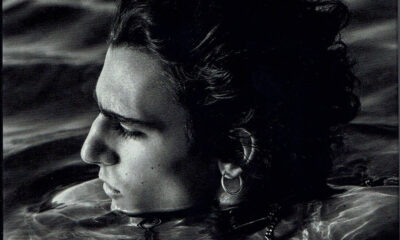Music
Inventions That Changed Music: The Phonograph
It all started with Thomas Edison.
Editor’s Note: As part of CMN’s ongoing music journalism program, we asked our team of music writers to research one invention that changed the history of music.
The 19th century saw one of the most important inventions of all time: The phonograph.
Invented by Thomas Edison in 1877, the phonograph was a device made of tin-foil that played back sounds recorded on round cylinders. This gadget was not the first invention to play recorded audio, but it is considered the most reliable of previous devices.

Most of the time I just hang around and listen to music in my room, you know. (Thomas Edison with his second phonograph, 1878. Image: Wikimedia Commons)
Edison’s work on the phonograph began when he decided to create a device that would capture and play back the human voice. To do this, Edison improved inventor Scott de Martinville’s concept. Edison and Martinville knew that an artificial diaphragm could capture sounds on a physical medium, but Edison wanted to find a way to reproduce those sounds. He first used paraffin paper, then spinning tin foil wrapped cylinder.
According to Soundrecordinghistory.net, “This recording medium enabled the reading pin to transfer previously recorded vibrations back to the diaphragm where they will be reconstructed into sound.”
To test his new invention, Edison first recorded himself reciting the nursery rhyme “Mary Had a Little Lamb.” One year after the release of the phonograph, Edison predicted, “The phonograph will undoubtedly be liberally devoted to music.”
Smithsonianmag.com says, “Even as it changed the nature of performing, the phonograph altered how people heard music.”
Prior to the invention of the phonograph, people in the mid-1800s had two options when it came to listening to music: attend a live performance or play the music themselves.
The phonograph allowed people to listen to whatever music they wanted, when they wanted, where they wanted, and for as long as they wanted. People began listening to music differently, people could now analyze lyrics in depth. The phonograph was also instrumental in the development of jazz. Because of the phonograph, jazz musicians were able to learn intricate pieces by playing records over and over, studying the song until they figured out the notes.
Although the phonograph was well-received upon its release, it was not a flawless invention.
The early phonograph played back sounds that were barely audible. In addition to that, it had poor sound fidelity. When it came to recording music, musicians faced many challenges. According to Smithsonianmag.com, “Recording was physically demanding. To capture quiet passages, singers or instrumentalists would often have to stick their face right into the recording horn.”
Despite these challenges, the phonograph remained an essential part of the music industry.
As the world of music changed, so did the format of songs. The duration of songs became shorter with the invention of wax cylinders. These discs, invented by Emile Berliner, could only hold two to three minutes of audio. Composers found themselves editing their work in order for their music to fit onto these discs.

Berliner Model 18 phonograph (Image: Vintage Radio)
Author and University of North Carolina music professor Mark Katz says, “The three-minute pop song is basically an invention of the phonograph.”
Critics doubted the phonograph would have any commercial success. However, Edison’s invention went on to revolutionize the recorded music industry. People were able to enjoy music freely, which led to a market for buying records.
Edison’s phonograph changed the world and became his most notable invention. According to Thoughtco.com, “His products made it possible for professional quality music to be heard in any home.”
If you obsess over singers and bands, and are one of those people who make a playlist for every occasion, join CMN’s Music Journalism Course and get real-time experience, intense feedback on your writing, exposure to music industry insiders, and a great place to display build your portfolio. Get all the details on the Music Journalism Course here.











